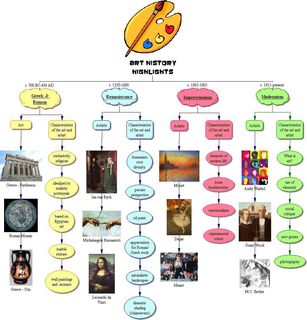A Brush with History: Journeying Along the Captivating Art Timeline
Let's look at the captivating realm of art history, a trove of knowledge often unexplored by many artists. While I've briefly touched upon movements like Prehistoric art, and of course Realism and Impressionism in previous posts, let's embark on a thrilling journey through time, tracing the intricate connections between these artistic currents on a fascinating timeline. Prepare to be captivated as we unveil how earlier movements undoubtedly influenced the emergence and development of subsequent styles.
One of the intriguing aspects of this exploration lies in the surprising placements of specific movements within the timeline. Take, for example, the Gothic style, which predates the illustrious Renaissance period. The towering cathedrals and intricate stone carvings of the Gothic era were artistic marvels that left an indelible mark on the landscape of art history long before the dawn of the Renaissance's rebirth of classical ideals.
Meanwhile, other connections may appear glaringly obvious, inviting a nod of recognition and a sense of artistic evolution. Consider the dynamic interplay between Post-Impressionism and its predecessor, Impressionism.
Post-Impressionist artists like Vincent van Gogh and Paul Cézanne, while initially influenced by the groundbreaking techniques and subject matter of Impressionism, ventured further into exploring the realms of colour, form, and personal expression. Their bold brushwork and vibrant palettes breathed new life into the art world, leaving an enduring legacy that expanded upon the foundations laid by their Impressionist counterparts.
As we traverse this artistic timeline, we encounter many movements and styles, each with its unique narrative and impact. From the groundbreaking experiments of the Cubists, who shattered traditional notions of representation and embraced multiple perspectives, to the rebellious spirit of the Dadaists, who sought to challenge and subvert conventional artistic norms, the evolution of art becomes a captivating story of creative innovation and cultural expression.
What Happened When?
Furthermore, this exploration of art history allows us to observe how specific movements emerged as responses to their time's social, political, and technological shifts. For instance, the stark realism of the Ashcan School artists depicted the gritty realities of urban life in early 20th-century America, capturing the essence of a rapidly changing society. Similarly, the abstract expressionists of the mid-20th century, with their bold and emotionally charged works, mirrored the turmoil and existential questioning prevalent in the aftermath of World War II.
By delving into the fascinating tapestry of art history, we gain a deeper appreciation for the interconnectedness of artistic movements and the enduring impact of their pioneers. It becomes clear that art, far from a solitary endeavour, thrives within a larger context, influenced by the ebb and flow of history, culture, and individual vision.
So, join me on this enthralling journey through time as we unravel the threads that connect art's past, present, and future in a condensed timeline.
Although we have briefly touched on the surprising connections, and the pivotal moments, that shape the ever-evolving landscape of artistic expression this post is more about showing you the timeline of art history as a reference. You can view that below.
Prepare to be forever transformed by the rich tapestry of art history, where the brushstrokes of countless visionary artists have left an indelible mark on the canvas of human creativity.
Take a look at a condensed but captivating journey through art history's timeline, to see what happened and when.
A Timeline of Art History
ANCIENT CIVILIZATIONS 3000 BC - 331 BC
Egyptian Art 3200 - 1070 BC
Amarna Art 1370 - 1340 BC
Mesopotamian Art 3500 - 331 BC
Sumerian/Akkadian 3500 - 1750 BC
Assyrian/Neo-Babylonian 1000 - 539 BC
Persian 539 - 331 BC
Aegean Art 3000 - 1100 BC
Minoan (Crete) 3000 - 1475 BC
Mycenean (Greece) 1650 - 1100 BC
Greek Art 800 - 323 BC
CLASSIC CIVILIZATIONS 800 BC - 337 AD
Hellenistic Art 323-150 BC
Etruscan Art 6th - 5th century BC
Roman Art 509 BC - 337 AD
MIDDLE AGES 373 - 1453 AD
Celtic, Saxon, & Hiberno 200 - 732 AD
Byzantine Art 400 - 1453 AD
Justinian 527 - 565 AD
Islamic Art 622 - 900 AD
Carolingian Art 732 - 900 AD
Ottonian Art 900 - 1050 AD
Romanesque Style 1000 - 1140 AD
Gothic Style 1140 - 1500 AD
RENAISSANCE 1400 - 1800 AD
Renaissance: Italy 1400 - 1600 AD
Renaissance: Europe 1500 - 1600 AD
Baroque 1600 - 1700 AD
Rococo 1700 - 1750 AD
PRE-MODERN 1800 - 1880 AD
Neo-Classicism 1750 - 1880 AD
Romanticism 1800 - 1880 AD
Realism 1830's - 1850's AD
Impressionism 1870's - 1890's AD
MODERNISM 1880 - 1945 AD
Post Impressionism 1880 - 1900 AD
Expressionism 1900 - 1920 AD
Fauvism 1900 - 1920 AD
Cubism 1907 - 1914 AD
Dada 1916 - 1922 AD
Bauhaus 1920s - 1940's AD
Harlem Renaissance 1920s - 1940's AD
Surrealism 1924 1920s - 1940's AD
International Style 1920s - 1940's AD
MODERN & POST-MODERN 1945 AD until now
Abstract Expressionism 1945 - 1960 AD
Op Art 1960s AD
Pop Art 1960s AD
Minimal Art 1960s AD
New Realism 1970s - 1980s AD
Conceptual Art 1970s - 1980s AD
Performance Art 1970s - 1980s AD
Neo-Expressionism 1980s - 1990s AD
Computer Art 1980s - 1990s AD
Post-Modern Classicism 1980s - 1990s AD
Victorian Revival 1980s - 1990s AD
If you're interested in other art styles please take a look at my art blog for all things art including some other art history.
If you want a more complex and informative look at art history there is much to be discussed and studied. In the meantime, Check out this page for further analysis.
Posted: Tuesday 30 March 2010
